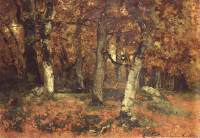
It was like a dream come true: Paál travelled to Barbizon in 1873 where he was to indulge in a wonderful landscape which had already inspired so many artists. Paál who grew up close to vast forests in Transylvania now focused his art on the forest of Fontainebleau. Yet, it did not bring any monotony to his pictures. He portrayed his subject matter in different seasons, at different parts of the day, when light and atmospheric conditions changed and even if they returned in some of his compositions, nature always appeared different, reflecting Paál's mood.
While pictures painted in the Netherlands had a wider horizon of plain landscape, he observed and painted the innermost parts of the forest. He was particularly good at portraying characteristic features and variations of trees, with groups of trees representing space. This bright picture showing a wood was painted in November of his first year in Barbizon and it shows that Paál's art had been fully developed by then. He had had his first major success, he had won a medal at the World Exhibition in Vienna, he was self-confident of his art, and never followed the style of any of the artists in Barbizon. The riot of autumn colours is present in the scattered shadeless light in the deep forest with a relatively strong intensity.